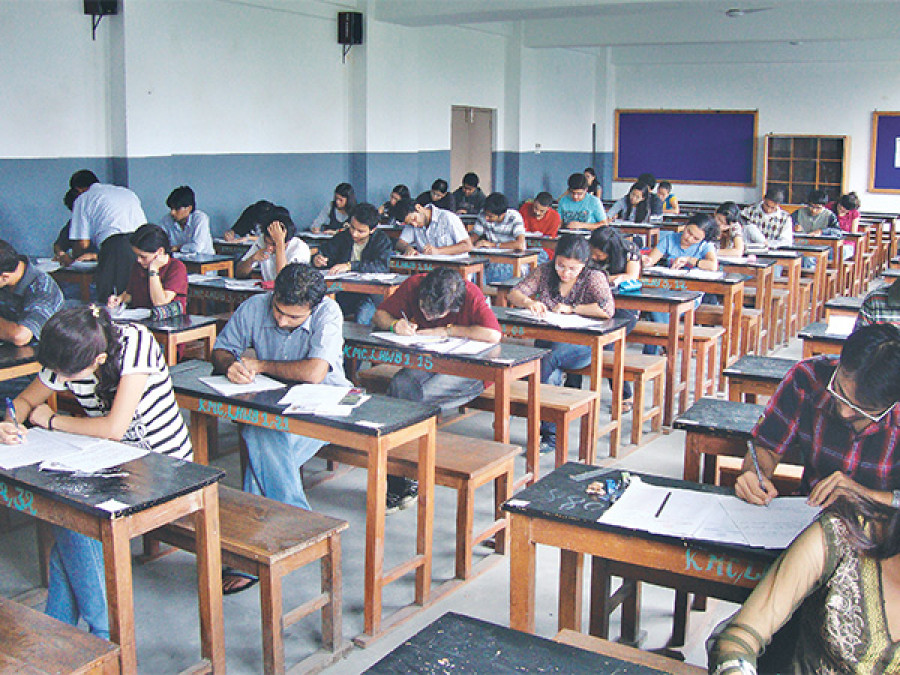Miscellaneous
Reforming a diseased sector
We worked for 1,500 hours on the report. We had such long, rigourous discussions at Singha Durbar that by the time
Manish Gautam
Last Sunday inside the Cabinet Room at the PM’s residence, in Baluwatar, the former Tribhuvan University Vice-chancellor could finally relax. Both Prime Minister Sushil Koirala and UCPN-Maoist leader Pushpa Kamal Dahal ‘Prachanda’ too were in high spirits as Mathema and his team members handed over the report on the much-awaited medical education policy. The policy is expected to direct the country’s future course of medical education, which has often times been mired in controversies to do with college affiliations and the deteriorating quality of services in the medical education sector.
The committee was formed in November of last year after a hunger strike staged by Dr Govinda KC. Dr KC, an orthopaedic surgeon at the Tribhuvan University Teaching Hospital, Maharajgunj, was then on his fifth hunger strike, demanding reforms in medical education. The government had tried to assuage Dr KC earlier, but upon realising that Dr KC would not give in, it had asked Mathema to lead the committee that was to draw up the details on the reforms.
One of the most bizarre, vexing issues in the health sector is the sheer inequality in terms of health services available at the country’s centre and at the peripheries. While the life-expectancy averages for the country has now reached 65 years, people in Mugu, in Karnali, for example, still have an average life-expectancy of just over 35 years. Almost every year, people in the less developed areas die of diseases, including from diarrhoea, dysentery and cholera; many others succumb to the injuries they suffer from all manner of incidents, from road accidents to falls; many of these deaths can be averted if the patients only had proper medical attention.
The basic premise of Mathema’s report is that people should have the right to access healthcare regardless of where and how they live.
Towards this end, the ‘Health Profession Education Policy’, as the document is named, recommends an overhauling of the entire system of health education and health systems. The policy also firmly states that the task can be carried out only after decentralising medical colleges first. Among the country’s 23 medical colleges, seven lie inside the Kathmandu Valley, and four more colleges may soon get established here.
“If we believe in equitable distribution of healthcare, there is no option but to set up medical schools away from the centre,” says Mathema. His claim, which is similar to Dr KC’s, is based on simple logic: if you build medical colleges outside the Capital, the people in districts will have access to a quality health centre. Furthermore, the colleges can provide a much needed shot in the arm to the economies of these areas.
The other major restructuring recommendation made in the report has to do with the management practices at Nepal Medical Council (NMC). The NMC has the sole authority to conduct licensing exams, regulate doctors and monitor medical colleges, among other tasks. However, the NMC has routinely been buffeted by controversies stemming from their inability to monitor medical colleges; there have also been many allegations over the years that the council’s members have been taking undue favours from private colleges, in return for which, they have allowed some of the colleges to get away with providing sub-standard education.
“The NMC is already overstretched. It needs restructuring,” says Dr Bhagwan Koirala, a member of the council.
To remedy this problem with logistics, the report has proposed the creating of a commission to oversee six different tasks through six directorates. The directorates will also be responsible for providing accreditation, holding entrance examinations at medical colleges and monitoring medical institutions, among other tasks.
It has been six days since the report was submitted to the prime minister, but it has not been made available for public debate yet. Officials say they are still reviewing the document. They know that once the report is released to the public, there will be stiff opposition from some quarters.
One of its recommendations will probably be challenged right away. It states that no new medical institution, even if the founders have already invested in its infrastructure, shall be allowed to be established inside Kathmandu Valley. The investors, if they so wish, can instead hand the college over to the government.
Some of these incipient institutions include the Manmohan Memorial Institute of Health Sciences, chaired by CPN-UML lawmaker Rajendra Pandey; the National Medical College, an extension of the Birgunj-based National Medical College promoted by UCPN (Maoist) loyalist Basaruddhin Ansari; and the People’s Dental College, run by Sunil Sharma, who has support from the Maoists and the Nepali Congress. The policy recommendation implies that these investors have been using their political clout to get the affiliation required to run their medical college. The political implications that the recommendations will have and the affiliation row being discussed in parliament has put the government in a difficult position.
In the past, the government has not handled such matters with dexterity. A few months ago two reports on medical university practices and a draft standard of medical education were completed. But their recommendations were not implemented by the Ministry of Education.
Interestingly, although Mathema has worked on many important educational restructuring issues, such as the reformation of the SLC system, many of them have not been implemented either. This time around, he has the support of Dr Govinda KC, popular among the masses for his philanthropy and for his crusade to bring about changes in the medical education sector.
In a few days the duo will be in for quite a battle.




 12.12°C Kathmandu
12.12°C Kathmandu










